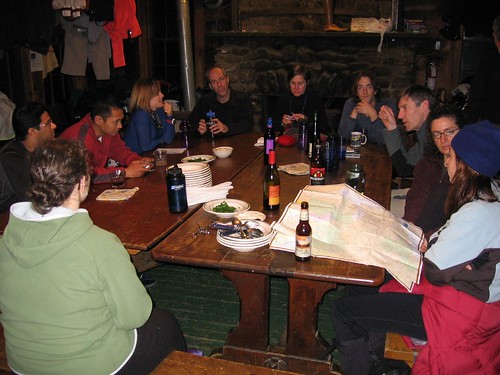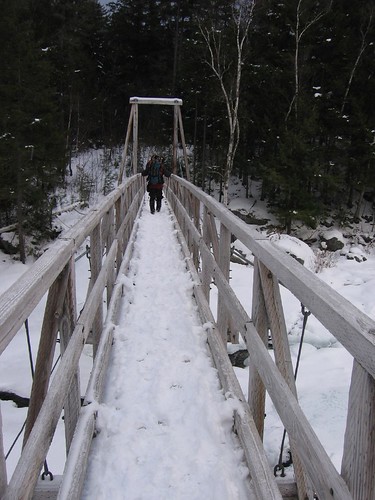
Photo show
- Where there is always a tea party -
 Things I learned or would like others to learn.
Things I learned or would like others to learn. That extreme cold numbs the brain and slows down response time was not an excuse we could use. Well, not yet. Especially after a comfortable and cozy drive to New Hampshire and Harvard Cabin for the winter hiking program “debug the gear”, weekend in December.
That extreme cold numbs the brain and slows down response time was not an excuse we could use. Well, not yet. Especially after a comfortable and cozy drive to New Hampshire and Harvard Cabin for the winter hiking program “debug the gear”, weekend in December.According to a report in today’s Boston Globe, applications for citizenship in
Increased fees, up from $400 to $675, concern that immigrants legally in the country may get caught up in changes to the law affecting those here illegally and a desire to vote in the 2008 elections are cited as part of a perfect storm.
An unstated concern may be that the Patriot’s Act of 2001 denies habeas corpus to legal resident aliens.
The net result is increased processing time up from the seven months currently quoted to an unspecified duration.
Even before the fee increase, announced in February 2007 and put in place in July the same year, I waited more than eight months for an interview. Add another month’s wait for the oath ceremony and the lead-time was at least nine months, and that was before the number of work visas that the Department of Immigration and Naturalization Services also process increased by 800,000 this year.
That’s not the end of the story, either.
Without an alien registration card, more commonly know as a green card, it is impossible to travel outside the country unless you have a passport. During the swearing in ceremony, immigration officials exchange the green card for a naturalization certificate. To obtain a passport the original certificate has to be sent in for processing.
The wait time for a passport recently was as high as three months, unless additional payment was made for expediting. The increased wait time was due to changes that require a passport for travel between the
Speaking of ID, not only is the wait time long, but during that time, the now naturalized citizen retains no evidence that they are a citizen or have any right to be in the country or is able to travel, say for a family emergency, outside of the country. Habeas what my newly minted Patriotic friend?
So is the current 12 months too long to wait for the privilege of being a fully documented
Of course not.
But don’t forget that the majority of immigrants wait at least five years from when they receive a green card and may wait longer than the 14 months I did for my green card, whilst in my case, here on a three-year work visa.
It’s an arduous, expensive, time consuming and often confusing process. So if you’re newly arrived, legally that is, you should start getting to know the candidates and planning to vote in the presidential election.
The one that’s due up in 2016, that is.
Tripping up the steps of
Maybe it was the strain of ambling up
Fortunately, two pairs of hands instinctively reached out from the top of the steps and I found myself pulled to safety from the top and pushed to safety from the bottom by my wife, who stood a step or two below me. The hands from above belonged to two of the course instructors, who later also introduced themselves as trip leaders for our winter hikes. I wondered as I brushed off my embarrassment if this wasn’t just the first of many times when helping hands would be required.
The Hiking and Backpacking Committee, H&B for short, of the Boston Chapter of the AMC runs this course annually, or has for the past six years. During this time they have developed a half-inch thick tome of knowledge, artfully titled ‘An Introduction to Winter Hiking’ - just in case the uninitiated thought that this was all there was to it.
Checking-in I collected my nametag and found myself a minor celebrity. Not only was my badge number 1, which meant I was the first to register and pay for the course, but I also shared the same family name with two of the instructors. We are not related, at least as far as I know, but within a few minutes of the start of the formal part of the evening, it felt as if I had joined a rather large family of similarly minded people.
Formal is too strong a word for events as they unfolded. It’s hard to be formal when someone stands barefooted in front of an audience in his underwear and explains the theory of heat management – which can be over-simplified as layers good, perspiration and cotton clothing bad. Not just bad, but very bad, bad to the point of forbidden.
The same goes for anything other than two-layer footwear; the sort that has removable liners is the only type of footwear allowed on AMC led winter hikes. Hard plastic mountaineering boots (similar to their downhill ski cousins) seemed to be the boot of choice for the majority of leaders in attendance, although at least one person favored the old stand-by Sorrel boot.
I don’t want to give the impression that these hardened devotees of winter solitude came dressed in expensive duds, although one person did sport a Arc’teryx® backpack that I know comes with a $549 price tag. Pants, stuff sacks and backpacks sported their fair share of duct tape patches, a simple remedy I suspect for a brush with unguarded crampons and ice axes or unavoidable tree limbs.
Perhaps the main advantage of attending the course, which works out at a meager $9 per week - apart from the obvious one of limiting the chances of ending up as a statistic in the New Hampshire Fish and Game annals of bad things that happen to others – is the opportunity to sign-up for those illusive winter trips I said I would do last year.
These are the ones I read about in AMC Outdoors or the Charles River Mud newsletter a week before they happen, or more usually a week or two afterwards.
Imagine that. Planning your winter hikes, secure in the knowledge that your destination hut or lodge is not booked up, that you will be in the company of like-minded or at least as insane people and led by an experienced hiker who has not only lived to tell the tale, but is willing to share the experience with a novice.
Roll on winter – at least until next week's session
 To my profound relief, the Lyric Stage performance of
To my profound relief, the Lyric Stage performance of I say that not because of poor writing, direction or acting.
The story of twin brothers (both played by actor Chris Thorn), one a gay actor, the other a marine Lieutenant, who dies under dubious circumstance in
The dialogue sparked, raged and sobbed with emotion as the story of their last night together unscrambled in the form of flashback action and current reality a year after his death.
Such was the concentration and pace of revelation of humiliation, abandonment and of a marriage gone sour, that at the end of the performance, I like the rest of the audience, sat in stunned silence, scarcely even breathing let alone applauding until the lights came up revealing the two actors smiling facings and bowing gestures.
Some saw the performances as histrionic or over the top. However, this is what happens – perhaps over a longer period, but it happens nonetheless.
The question is do we want to bear witness and to invade the privacy of a family with issues (even if fictional), in the name of entertainment. For those that have experienced such emotions, it is perhaps a timely reminder of past decisions. For those that have not – perhaps it may serve as a warning not to take such decisions lightly.
Not for the first time in the Lyric's cozy 'in the round' seating and intimate atmosphere did I give thanks for sitting further back than in the first three rows. Seated any closer, I would have been compelled to reach out a comforting arm and wrap it around Jennifer Blood's shoulder or to kick Chris Thorn's backside as due payment for his total lack of sensitivity.
This was theater for grown-ups. Sometimes it's better to be a kid.
 So with the parade over it was time to be 'Not An Englishman in
So with the parade over it was time to be 'Not An Englishman in The latter provided the impetus for a five-day break. That and expiring Air
Of course, I noticed the flailing US dollar purchased less and the unmistakable look of satisfaction on d' Canadians' friendly faces as we talked about where it had all gone wrong (or right depending on which side of the border you hang your woolly hat).
I spent almost an entire day in the newly minted Canadian War Museum – where amongst other things I learned with satisfaction that people from 1766 called patriots in the US are described less politely as 'The American Rebels' in Canada.
Indeed much of the early infrastructure, at least after General Wolf defeated a somewhat overzealous Montcalm to win Canada from the French, was established to defend a Canada loyal to the English crown from American infiltration.
Still the wine and food show presented a great opportunity to drink to the
The National Gallery of Canada, fresh with a photo exhibit 'Snap Judgment' featuring the brighter side of life in the continent of Africa (at least for the most part) presented an opportunity to replace the all pervasive images of disease, famine, warlords and genocide that are the 'photostock' trade of journalists and image makers. In addition, all of the images came from talented and in many cases self-taught, up-and-coming African photographers.
My own images of
I spent a wonderful afternoon on Halloween in the Earl of Sussex Pub, just people watching/listening. Everything changes, the whole dynamics of personal interaction, when at least one of the people is hiding behind a costume mask. Sadly, I was not one of them and could only marvel at the bravery of some souls.
 It was only right that I should show up to the Red Sox parade. Dashing off an article for this week’s paper on some not very interesting local politics, I dumped the car at Lincoln Station and took a commuter train packed to the gunnels with kids and young adults skipping school or work. Not for the last time that day did I feel old.
It was only right that I should show up to the Red Sox parade. Dashing off an article for this week’s paper on some not very interesting local politics, I dumped the car at Lincoln Station and took a commuter train packed to the gunnels with kids and young adults skipping school or work. Not for the last time that day did I feel old. 

It was a good day to claim allegiance to the home town team.
Red Sox and Fox, you are running me ragged.
Game start times in late evening, extended innings and nail-biting finishes are giving me a serious case of nervous exhaustion.
Soccer cup competitions, with extra-time and penalty shootout formula are tense, but quickly over in comparison.
In baseball, every pitch is a potential disaster or delight, for hour after hour. No wonder everybody in the ballpark drinks or eats to distraction or spits whatever they spit (and that seems to vary as much as each game).
Perhaps it’s that I don’t understand the nuance of the sport, that it’s OK to throw a ball instead of a strike to certain hitters, or to hit a sacrifice and be out. But I see the same tensions ebbing and flowing on the faces of thousands of fans, players and coaching staff. Commentators and journalists refer to it as ‘the changing momentum’ and boy is it fickle.
Even with the Sox sitting on a commanding lead, I still expect them to blow it in late innings, and I’ve only lived here for the past for seven years, perhaps the most successful since their early years.
I cannot imagine how lifelong fans deal with each experience building on the past, like grains of sand in a sandcastle that is inevitably washed away as the tide turns.
So please stop it. Go
Boston City Councilors are seeking to create a taxi passenger bill of rights along the lines of providing a safe, functioning and clean cab, with no music playing in the cab or cabbies chatting on cell phones while driving. In their response, according to an article in the Globe, cab drivers want a bill of rights for themselves; no drunk and vomiting passengers, no more than four passengers per cab ride and no abuse of the driver by passengers.
What I want is to pay via a fairs fare system, not take my life in my hands when I (rarely) take a cab and a driver who knows where he or (rarely) she is going.
I can say in all honesty, that I have never ever had a good or even satisfactory cab ride in
Journeys over 12 miles are charged at a flat, non-metered rate. A cab from
When I took a cab from Alewife T station to
I should have been clued in by the fact the driver disappeared for a few minutes when we got in his sweltering cab and left us sitting there while he talked to the driver behind him. I should have known when he did not start the meter that we were in for a flat rate and as it turned out a flat out ride.
We had been traveling from
Then the cab took us for a ride.
Loading our bags ourselves, we found that there was hardly room in the trunk for our two modest size suitcases (they weighed less than 42lbs each – thanks to judicious packing and the weight restrictions imposed on the Heathrow to
We could not see out of the cab windows, any of them, because they were so steamed up. More to the point nor could the driver, except through a fuzzy patch the size of a laptop screen.
When we reached the ramp at the
In fairness, he did get us home or at least to the top of the drive where he stopped on a our unlit narrow, but busy two-way road, 3 feet from the curb - without hazard indicators flashing.
I waited for the driver to tell me the fare, clutching a twenty and a ten, perhaps more in hope than any real expectation. I was definitely unprepared when he said the fare was $56.
I protested and asked to look at the book of fares. After five minutes of rummaging, he came up empty. I asked for the dispatch telephone number. That’s when I made my second mistake.
He dialed a number and spoke in a language I did not understand and then handed me his phone. I should have dialed the number on my phone.
The dispatcher, or someone who said he was the dispatcher, told me that the fare to
Did I get the cab drivers name, cab plate, registration or telephone number? No, as I mentioned it had been a long day, now going on 20 hours of travel and foolishly, I was keener to get off the pitch-black road and indoors after 17 days away.
Did I get wise to the cab industry in
I will never get in cab without checking that its lights work, the driver has a medallion with his picture on it and I know the price he is going to charge.
These are your rights and mine; everything else is just a load of bill.
Should we measure the value we have in our lives by the amount about which we have to complain?
I’ve been thinking about this a great deal recently.
For example, at the regatta on Saturday, an articulate, and to all outward appearances, well-fed and adequately clothed black man clutching a bundle of newspapers approached the crowds lining the riverbanks.
“Ladies and gentleman. Ladies and gentleman. Can I have your attention for just a moment? Can you help the homeless today? Can you spare a dollar to purchase a newspaper from me to help the homeless?”
Of course, I bought the $1 newspaper, called Spare Change, as did five or six people from the all-Caucasian crowd around me. The seller went on his way smiling and calling out the same line to garner attention from the next pod of spectators.
Inside the thin paper were articles on the laws affecting homeless people, editorials and advertising copy. There was also a warning to check the seller wore a blue badge. As with most things, these days there are several scams as this report in the Globe from last year indicates.
I have to admit I did not look for an ID - not for a dollar purchase/donation. Perhaps that says something about the relative value of a dollar to me as the buyer and to the seller, whether homeless or not.
On the inside back cover, a list of organizations indicated that it was possible to obtain hot food three times a day, various food supplies and somewhere to stay overnight. I don’t know the quality or general availability of such hospitality and in truth hope never to have to test it out of need.
Food, shelter and an opportunity to earn a small wage appeared to hold a greater value to that individual than seems apparent for those given to complaining about their boss or the traffic conditions on the journey to work. Throw into that mix their angst over rising mortgage repayments, shrinking house values and the stock market volatility. Take a break from that as you sip an overpriced Starbucks' latte and ponder whether the Red Sox have the right (highly paid) players to win the World Series and the difference is glaring.
One of my former bosses, consoling me after he told me that I would not get a pay rise that year because of conditions in the industry, said that I should actually thank him.
“It’s a well known fact,” he said, “that people live 10% beyond their salaries. I just saved you money.”
Perhaps he was right.

There has definitely been a theme of trying new things this year, although you will be forgiven for not knowing that due to the paucity of posts.
I plan to rectify the posting situation by resurrecting this blog and in the immortal words of Highlander, “There can be only one”, so this blog is it.
Strictly speaking I should remain the blog “An English/American in
Ok, I have ignored the Head of the Charles Regatta for the seven plus years I have lived in the Commonwealth. Not for me I thought – all those Ivy League types, the rowing community – men in caps and blazers that fit them thirty years ago parading with waspy-waist women in summer dresses, hospitality tents with cucumber sandwiches and white wine, jazz bands, pretentious awards and phony accents. No thanks, not for me sir.
Oh dear, it turns out that I was getting confused with the Henley on Thames Regatta, which I attended on one occasion to receive an award for design innovation – but that’s another story.
The Head of the Charles Regatta was real people having fun, pumped up with live rock and reggae music, lots of free stuff and blessed with glorious fall weather. Wave after wave of rowers, buff, synchronized, almost majestic, swept seemingly effortlessly up the river.
Being amongst fit people of all ages, doing what they enjoy is uplifting to the human spirit. It appeared so exhilarating I almost wanted to take up the sport, but I’ll probably settle for the stationary rowing machine at the gym. There’s less chance of capsizing that way.
 Today was an opportunity to get out and explore Salem, MA. More infamous for its much heralded and now commercialized witch trials, Salem is home to two institutions worth visiting. The first is the Peabody Essex Museum, recently renovated and expanded it bills itself as a cultural art museum. The emphasis is on maritime and Asian art, which seems and odd combination at first, but since Salem was once the premiere port in the New World, many artifacts from the Orient found their way to America via Salem.
Today was an opportunity to get out and explore Salem, MA. More infamous for its much heralded and now commercialized witch trials, Salem is home to two institutions worth visiting. The first is the Peabody Essex Museum, recently renovated and expanded it bills itself as a cultural art museum. The emphasis is on maritime and Asian art, which seems and odd combination at first, but since Salem was once the premiere port in the New World, many artifacts from the Orient found their way to America via Salem.
